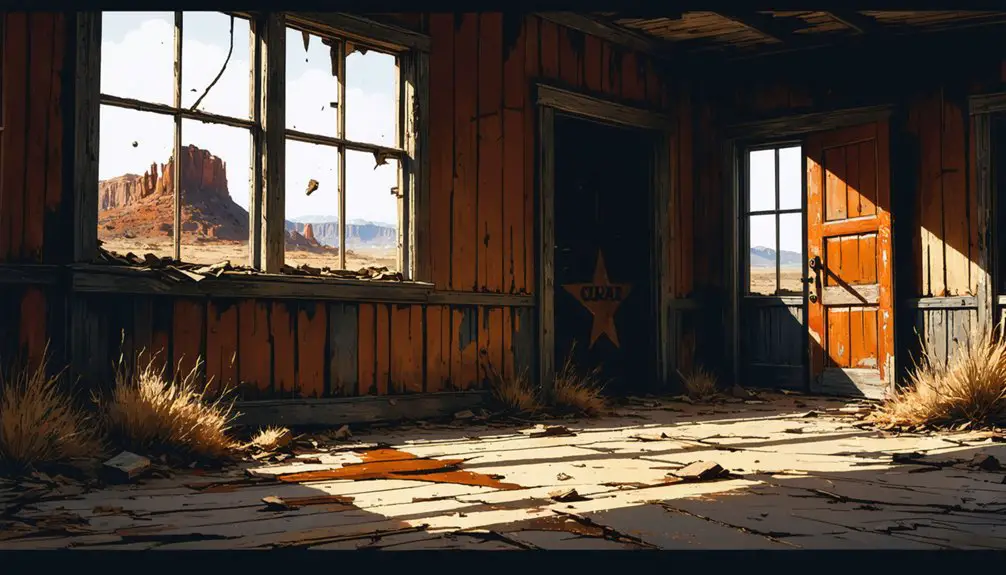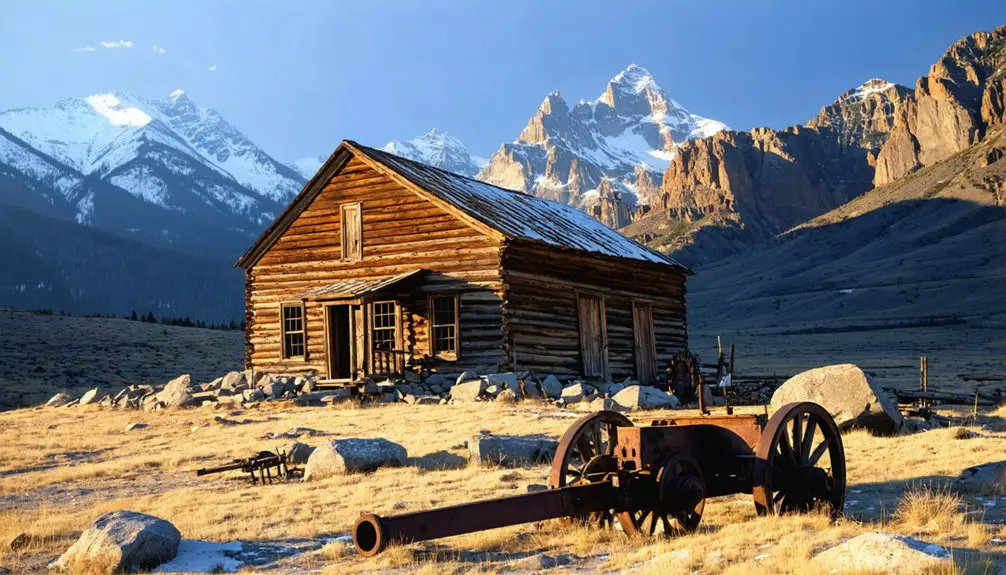You’ll find Bear Rock’s haunting remains along Wyoming’s historic Union Pacific Railroad route, where a thriving frontier settlement of 2,000 once stood in the 1860s. The town’s dramatic decline began after the deadly Bear River City Riot of 1868, which left 16 dead and much of the settlement in ashes. Marshal Thomas “Bear River Tom” Smith’s valiant stand against vigilante justice couldn’t save the town, but his story captures the raw spirit of America’s western frontier.
Key Takeaways
- Bear Rock was established in the 1860s as a Union Pacific Railroad town, growing to 2,000 residents during its peak.
- The notorious Bear River City Riot of 1868 led to 16 deaths and widespread destruction, marking the beginning of the town’s decline.
- Marshal Thomas “Bear River Tom” Smith’s heroic but futile defense against violent mobs became legendary in frontier law enforcement history.
- The town’s fate was sealed when rioters burned key structures, causing economic collapse and population dispersal.
- Today, Bear Rock stands as a ghost town, symbolizing the volatile nature of American frontier settlements and railroad expansion.
The Birth of a Frontier Railroad Town
Three key factors converged to birth the frontier town of Bear Rock in the early 1860s: the Union Pacific Railroad‘s westward expansion, the strategic crossing of the Bear River, and the intersection of major emigrant trails.
You’ll find that Salt Lake City businessman Joseph F. Nounnan played a crucial role, establishing supply depots and worker lodgings as he fulfilled his contract to build the railroad grade through southwestern Wyoming. Like many construction sites along the route, former Union officers managed and engineered the development of Bear Rock’s rail infrastructure.
The town’s prime location quickly attracted those seeking opportunities amid the frontier challenges. Railroad workers, miners, and hunters flocked to this essential transit hub where the Overland Stage Route met the California and Mormon Emigrant Trails. Like Bear River City, the town faced violent unrest during the Bear River City Riot which resulted in multiple casualties.
As Bear Rock tackled the railroad expansion head-on, its population swelled to 2,000 residents, transforming a simple construction site into a bustling frontier settlement.
Life Along the Union Pacific Route
While the Union Pacific Railroad‘s steel rails stretched westward across Wyoming Territory, workers faced brutal conditions that tested their resolve daily. You’d find them battling winter’s icy grip, using sleighs when frozen rivers halted ferry crossings, all while racing to meet ambitious construction deadlines.
The railroad expansion brought “hell on wheels” tent towns in its wake, where you could witness the raw energy of frontier life unfolding. Cavalry patrols protected crews from hostile encounters as they pushed through Indian territories. The timber and coal resources along the route proved crucial for maintaining the railroad’s operations. These workers achieved remarkable progress, setting a record of ten miles of track laid in a single day.
Under Chief Engineer Casement‘s leadership, these determined men laid track at breakneck speed, transforming Wyoming’s economic landscape. What started as temporary camps evolved into thriving communities, complete with railroading facilities and basic amenities that marked civilization’s steady march westward.
The Infamous Bear River City Riot
You’ll discover how a controversial vigilante lynching in November 1868 ignited Bear River City’s most destructive riot, as hundreds of armed desperados torched buildings and engaged in deadly street battles.
The Hell on Wheels town consisted mainly of tents and temporary structures that housed criminal elements and railroad workers.
The riot began when friends of the lynched retaliated violently against the vigilantes who had executed their companion.
Marshal Thomas “Bear River Tom” Smith bravely confronted the rioters but couldn’t prevent the destruction of the jail, newspaper office, and much of the town’s core.
With as many as 16 people dead and the U.S. Cavalry imposing martial law, the once-bustling railroad town never recovered from this violent episode that sealed its fate as a ghost town.
Vigilante Justice Sparks Violence
As lawlessness gripped Bear River City in 1868, tensions between vigilante groups and the town’s criminal elements erupted into one of Wyoming Territory’s deadliest riots.
What began as vigilante motivations to expel “roughs” from this hell-on-wheels railroad town quickly spiraled into chaos when a railroad worker’s alleged murder prompted swift, extrajudicial justice.
You’ll find that community outrage, stoked by the local Frontier Index newspaper, led vigilantes to hang three men who’d resisted expulsion.
This fatal decision triggered immediate retaliation from the victims’ allies. A mob of 300 men stormed through Bear River City, burning the jail, newspaper office, and merchant stores. The mob included angry Irish railroad workers seeking revenge against the newspaper’s critical coverage.
The ensuing violence claimed 16 lives and reduced the settlement to ashes, requiring U.S. Cavalry intervention to restore order. After the riot, the town’s fate was sealed when Union Pacific refused to construct a railroad siding.
Marshal Smith’s Heroic Defense
During the infamous Bear River City Riot of 1868, Marshal Thomas “Bear River” Smith emerged as a central figure in one of Wyoming Territory’s most violent confrontations.
As chaos erupted between vigilantes and railroad workers, you’d find Smith in the thick of the melee, fighting with his signature bare-knuckle tactics rather than drawing his gun.
Smith’s legacy centers on his fierce physical combat skills and unwavering courage, even as he faced overwhelming odds.
When gunman Miles attacked him with both firearm and axe, Smith fought to his last breath.
Though historians debate whether he acted as hero or instigator, Smith’s tactics of non-lethal force influenced future lawmen’s approaches.
His final stand helped delay the town’s destruction until federal troops from Fort Bridger could restore order.
His reputation as a skilled fighter was well-established from his time as a professional boxer in New York.
After leaving Bear River City, Smith went on to become the marshal of Abilene, where he earned $150 per month maintaining law and order.
Town’s Fiery Final Hours
The infamous Bear River City Riot of November 19, 1868, marked the violent death knell of this once-promising Wyoming railroad town.
As darkness fell, you’d have witnessed a mob of 300 armed desperados setting the town ablaze, starting with the jail and the Frontier Index newspaper office.
The streets erupted in fierce gunfights between vigilantes and the friends of lynched railroad workers, leaving 16 dead in their wake.
Marshal Smith’s Stand Against Violence

When Marshal Thomas J. Smith confronted hundreds of rioters during Bear River City’s darkest hour in 1868, you’d have witnessed his unwavering determination to uphold the law against both vigilantes and their violent opposition.
You can still picture the chaos as Smith, nicknamed “Bear River Tom,” defended the town jail through multiple shootouts that left both rioters and citizens dead amid the burning buildings.
Through Smith’s resolute stand against frontier lawlessness, you’re reminded of how a single lawman’s courage helped shape Wyoming’s early history, even as the town itself faded into abandonment.
Lawman’s Heroic Last Stand
Amid escalating tensions in Bear River City during November 1868, Marshal Thomas J. Smith faced a formidable challenge of frontier justice when vigilantes lynched a railroad worker, triggering violent retaliation.
As the town’s newly appointed law enforcement officer, Smith stood his ground against overwhelming odds to maintain order.
- Confronted armed mobs attempting to storm the jail
- Protected government buildings from destruction, despite numerous fires
- Earned his nickname “Bear River Tom” for his unwavering courage
- Repelled multiple attacks while vastly outnumbered
Despite Smith’s heroic efforts, the riot claimed 16 lives and destroyed most of the town.
You’ll find that his valiant stand couldn’t prevent Bear River City’s ultimate fate as a ghost town, though his actions exemplified the determination of frontier lawmen to uphold justice in Wyoming’s untamed railroad towns.
Defending Against Vigilante Justice
Marshal Thomas J. Smith faced a defining challenge when vigilante groups ignited violence in Bear Rock during November 1868.
You’ll find his story represents the raw struggle between formal law enforcement and frontier justice. After vigilantes lynched a railroad worker accused of murder, Smith confronted both the lynch mob and the victim’s vengeful allies who sought retaliation.
Under Smith’s leadership, townspeople defended critical structures, particularly the jail, where fierce gunfights erupted.
Steve Stokes fell defending the facility, while multiple rioters died in failed assault attempts.
Though Smith’s determined resistance saved lives, the overwhelming force of several hundred rioters eventually set the town ablaze.
His stand against vigilante violence, though ultimately unable to save Bear Rock from destruction, exemplified the dangerous complexities lawmen faced in Wyoming’s untamed frontier.
From Boomtown to Ghost Town Legacy
Though Bear Rock started with promising prospects as a bustling railroad supply hub in the 1860s, its transformation into a ghost town serves as a stark reminder of the fragile nature of frontier settlements.
A devastating riot in 1868 triggered the town’s rapid decline, as its transient population scattered and economic decline set in.
Today, you’ll find Bear Rock’s legacy preserved in these defining elements:
- Remnants of a once-thriving supply depot that served countless westward-bound pioneers
- Historic records documenting the volatile mix of railroad workers, miners, and frontier justice
- The town site itself, a reflection of the boom-bust cycle of American frontier expansion
- Stories of Marshal Smith’s stand during the riot, which later influenced law enforcement approaches in the West
Preserving Wyoming’s Railroad History
When the Pacific Railroad Acts of 1862 and 1864 released an unprecedented wave of railroad development across Wyoming, they set in motion a legacy that preservation groups now work tirelessly to protect.
Today, you’ll find this rich history carefully preserved in museums and interpretive centers throughout Cheyenne and Laramie, where historical artifacts tell the story of Union Pacific’s transformative impact on Wyoming’s landscape.
You can trace the evolution of Wyoming’s rail network from its humble beginnings to its 1940s peak of over 2,000 miles of track.
Local historical societies have worked to save everything from original depot buildings to construction camp remnants, ensuring that future generations can understand how the railroad shaped Wyoming’s development from a territory of 8,000 to a thriving state of 60,000.
Frequently Asked Questions
Are There Any Remaining Structures or Ruins Visible at Bear River City Today?
You won’t find any historic remnants for urban exploration at Bear River City today – nothing remains visible at the original site except a historical marker in Wyoming’s landscape.
What Happened to Marshal Thomas J. Smith After Leaving Bear River City?
Like a rising Western star, you’ll find Smith’s legacy continued as he became marshal of Kit Carson, Colorado, before taking his final post in Abilene, Kansas, where he met a violent end.
How Many People Lived in Bear River City During Its Peak Population?
During Bear River City’s peak in the late 1860s, you’d have found nearly 2,000 people there, with population statistics showing mostly railroad workers and laborers transforming this future ghost town’s bustling streets.
Were There Any Notable Native American Conflicts Around Bear River City?
You’ll find the most significant Native American conflict was the Bear River Massacre of 1863, where U.S. troops killed hundreds of Shoshone. This led to forced treaties establishing reservations in Idaho and Wyoming.
Did the Union Pacific Railroad Maintain Any Presence After the Town’s Decline?
While millions of trains thundered past, Union Pacific’s railroad influence stayed strong through maintained tracks and bridges, though you’d find no company buildings at the site after its economic impact faded.
References
- https://sites.rootsweb.com/~wytttp/ghosttowns.htm
- https://www.nps.gov/deto/learn/historyculture/first-stories.htm
- https://travelwyoming.com/blog/stories/post/bear-lodge-the-sacred-history-of-devils-tower/
- https://www.earthdate.org/episodes/devils-tower
- https://www.visitrapidcity.com/blog/post/the-story-of-devils-tower-national-monument/
- https://www.wyohistory.org/encyclopedia/industry-politics-and-power-union-pacific-wyoming
- https://en.wikipedia.org/wiki/History_of_Wyoming
- https://digitalcommons.usu.edu/context/elusive_docs/article/1074/viewcontent/navigational_history_bear_river.pdf
- https://www.wyohistory.org/encyclopedia/evanston-wyoming
- https://insidegmt.com/1867-big-wyoming-capturing-wyoming-rail-history/



